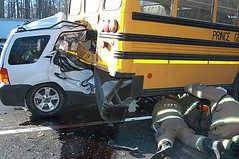Another vote for walkable schools as school bus crash kills one in Prince George's County

Another vote for walkable schools as school bus crash kills one in Prince George's County
Originally uploaded by rllayman.
One of the strategies I promote in terms of maintaining historic school buildings in town centers rather than big campuses on the outskirts of communities and everyone has to drive or be driven to the school is to focus on the myriad costs involved in a school bus infrastructure:
--the vehicles, which have to be maintained and replaced;
--the drivers, which are increasingly hard to find given the pay compared to the cost of housing, not to mention the difficulty of managing the students;
--fuel, which as we know is going up higher and higher; and
--the accidents, which don't usually result in deaths of children, although such did happen last year in Arlington County, but do result in many deaths of non-children (something that I started paying more attention to after the Arlington bus-garbage truck accident last year).
There are many reasons to favor compact development. Note that while center cities in the core of the region, such as Washington and Baltimore prepare to close many schools, fast-growing Loudoun County in Virginia plans to build 19 new schools. See Schools' Master Plan Grows by 19 Campuses from the Washington Post.
Index Keywords: education; sprawl; car-culture



0 Comments:
Post a Comment
<< Home